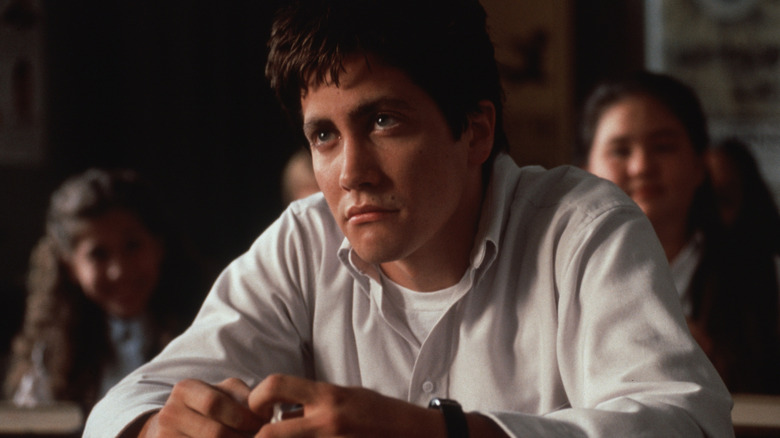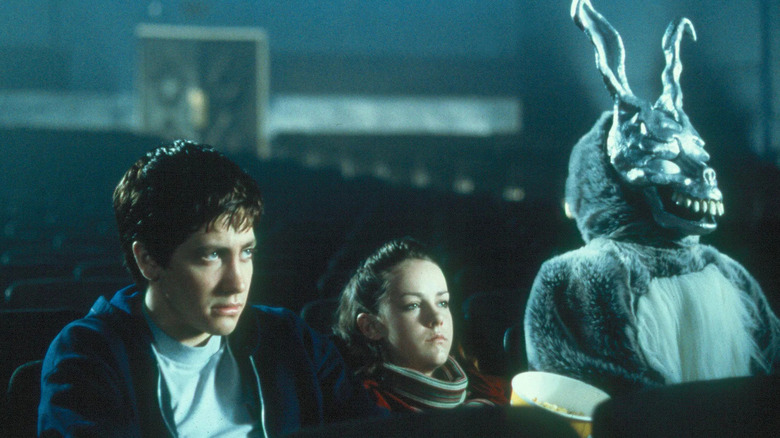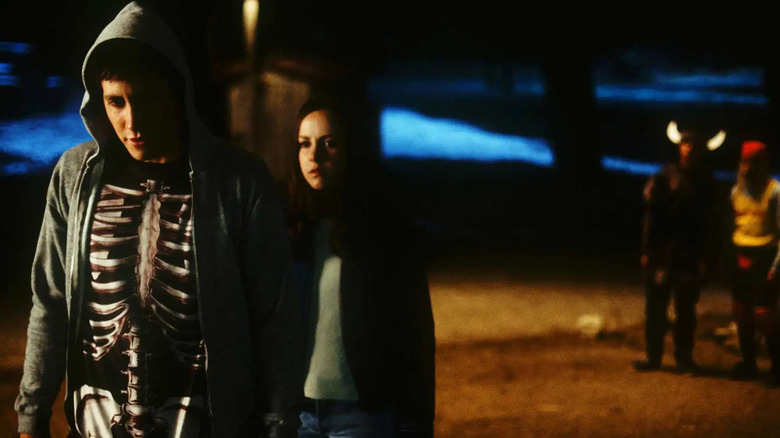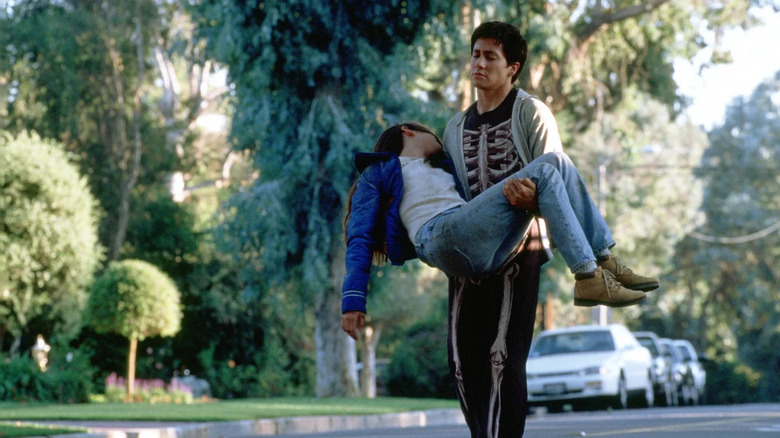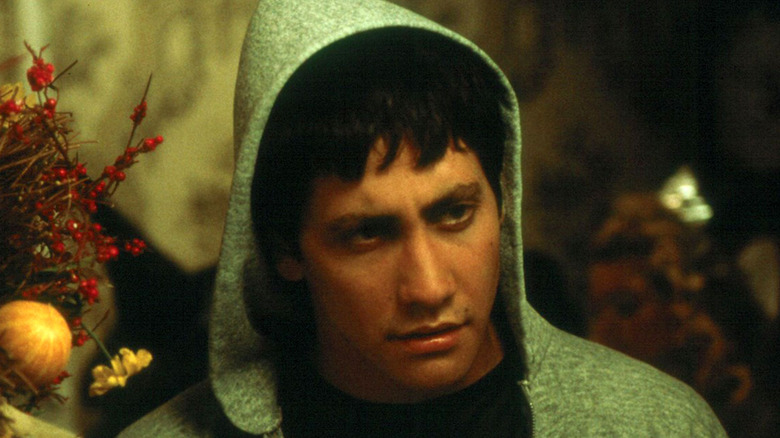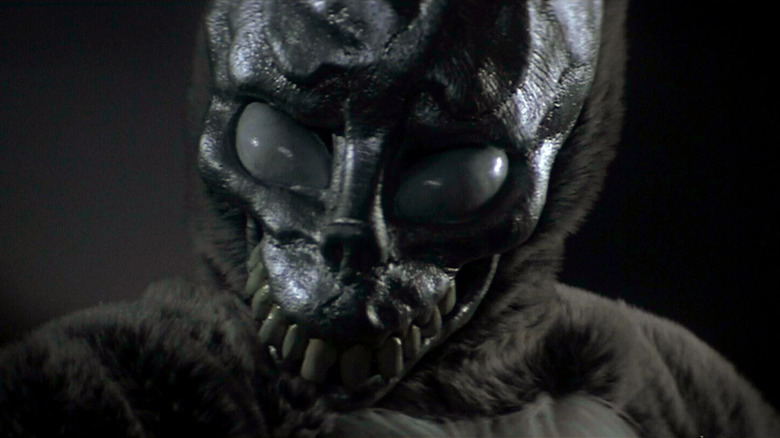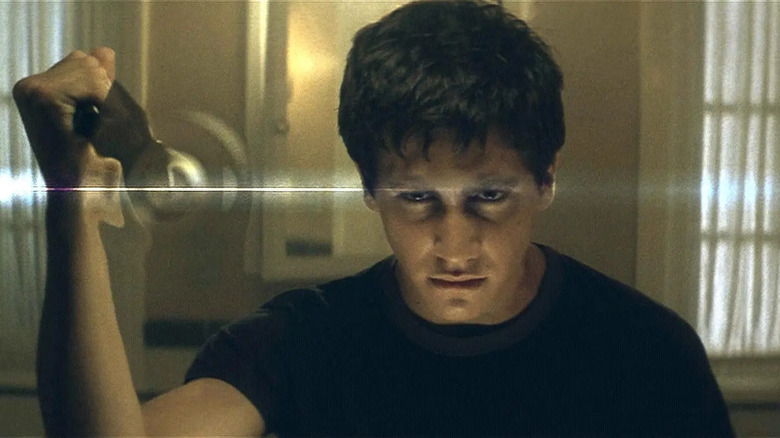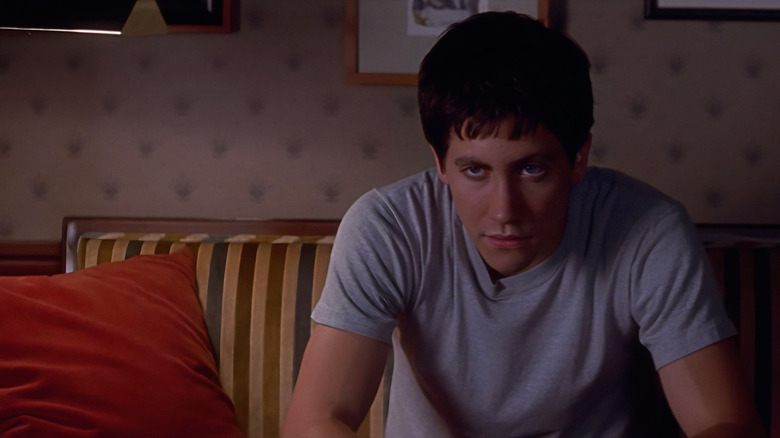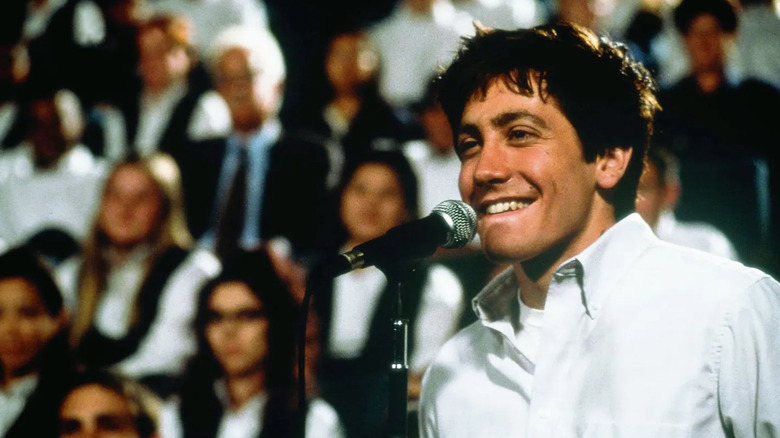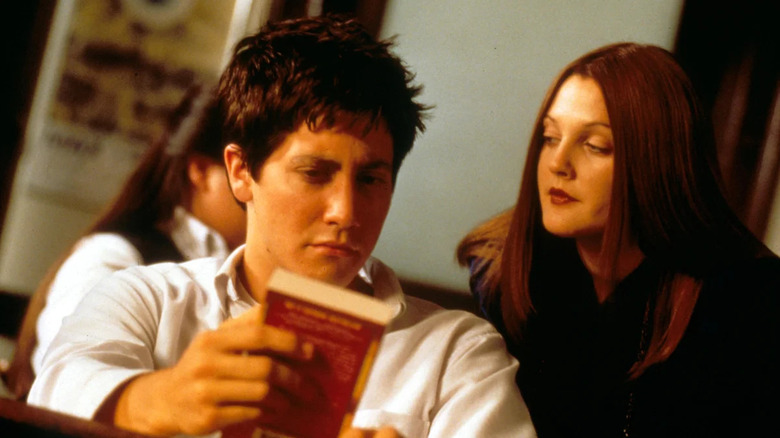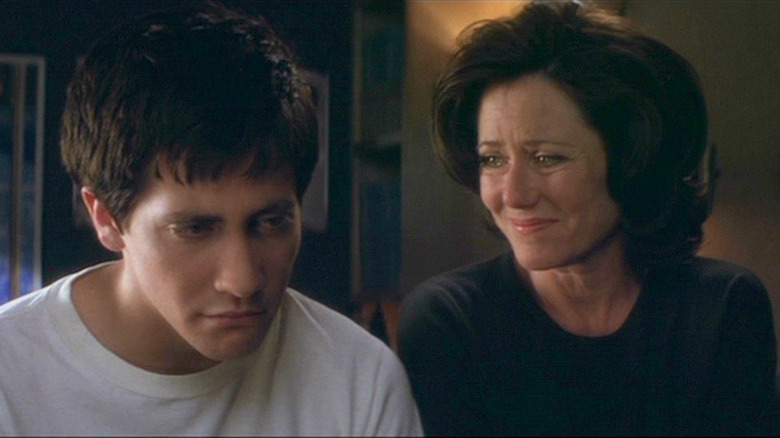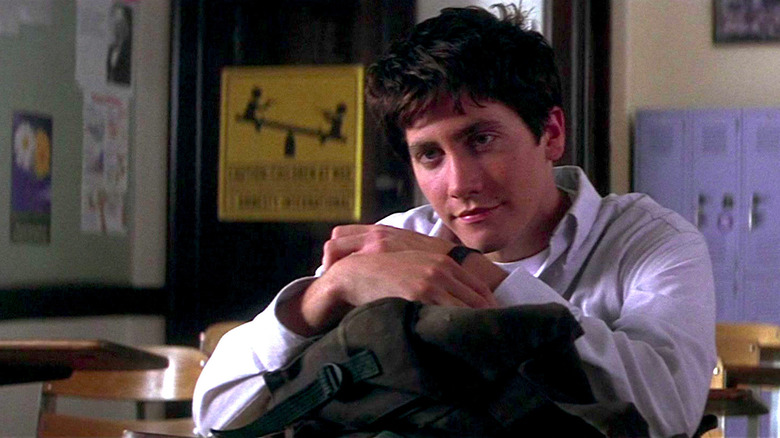Donnie Darko Ending Explained
Few films have been as hotly debated, discussed, and dissected as "Donnie Darko." Richard Kelly's first feature began stirring the conversational pot when it premiered at the 2001 Sundance Film Festival, where it perplexed and delighted audiences in almost equal measure. It opened in theaters on October 26 of that year, less than two months after the events of September 11, making its morbid story and apocalyptic imagery eerily relevant.
Despite earning critical praise, audiences stayed away, undoubtedly hesitant to watch a film revolving around a plane crash so soon after 9/11 made that scenario a frightening reality. Yet it quickly won a cult following that persists to this day, as diehard fans and new converts alike find themselves pondering over its various themes and meanings, especially when it comes to the ending.
Is there an easy way to explain the ending of "Donnie Darko"? Well, yes and no. Yes in the sense that there is an ending that can be discussed, and no in the sense that any interpretation of that ending will change depending on who you talk to. It's just one of the many reasons why the film has continued to inspire passionate discussions, even if by the end you might be left more confused than you were before. With that in mind, let's take a deep dive into the ending of "Donnie Darko": what happens, what it means, what it might also mean, and what we're ultimately meant to take away from it.
What you need to remember about the plot of Donnie Darko
On October 2, 1988, troubled teenager Donnie Darko (Jake Gyllenhaal) is visited by a giant, monstrous rabbit named Frank, who tells him the world will end in 28 days, six hours, 42 minutes, and 12 seconds. The next morning, Donnie awakens on a golf course after another night of sleepwalking, and returns home to find an airline jet engine has fallen through the roof of his bedroom.
Donnie continues to have visions of Frank, who influences his behavior, even encouraging him to flood his school. His parents, Eddie (Holmes Osborne) and Rose (Mary McDonnell), send him to a psychotherapist, Dr. Thurman (Katharine Ross), who believes he's suffering from daylight hallucinations that are indicative of paranoid schizophrenia. Donnie, meanwhile, starts dating a new student, Gretchen Ross (Jena Malone), who's fleeing her violent stepfather.
After Donnie floods his school, dogmatic gym teacher Kitty Farmer (Beth Grant) places the blame on new English teacher Karen Pomeroy (Drew Barrymore), who has assigned Graham Greene's short story "The Destructors" to her class. She starts teaching "attitude lessons" by motivational speaker Jim Cunningham (Patrick Swayze), who she invites to speak at an assembly. At Frank's behest, Donnie steals Jim's wallet and burns his house down, leading to the discovery of child pornography in his basement. Desperate to testify at Jim's trial, Kitty asks Rose to chaperone the school's dance trip to Los Angeles, where their younger daughters will perform.
What happens at the end of Donnie Darko?
With their parents out of town, Donnie and his older sister Elizabeth (Maggie Gyllenhaal) decide to throw a costume party for Halloween. Gretchen shows up, worried that her mother has been hurt by her stepfather after she goes missing. Knowing that the end of the world is nigh, Donnie takes Gretchen to find Roberta Sparrow (Patience Cleveland), aka "Grandma Death," a former science teacher who wrote a book called "The Philosophy of Time Travel" before seemingly going senile.
Searching for answers, they instead find bullies Seth (Alex Greenwald) and Ricky (Seth Rogen), who are looking for a fight. Their confrontation is interrupted when Roberta returns home and a car swerves to avoid hitting her, running over Gretchen instead. The driver is Elizabeth's boyfriend, Frank Anderson (James Duval), who's dressed as the menacing rabbit for Halloween. Donnie shoots Frank in the eye, leaving with Gretchen's lifeless body.
Donnie takes Gretchen's body to a mountain ridge overlooking the town, where he sees a vortex forming over his house. The airplane carrying his mom and younger sister, Samantha (Daveigh Chase), gets swept up in it, causing one of the jet engines to break off. Donnie awakens in his bed on October 2, right as the jet engine falls through his roof and kills him. Gretchen, now brought back to life, sees the commotion forming around the Darko house as Donnie's body is carried away, never realizing how close she came to her own demise.
What the end of Donnie Darko means
The most obvious interpretation of the finale of "Donnie Darko" is that Donnie is stuck in a time loop, as the story begins and ends on the same day, October 2, 1988. The first time that date comes and goes, Donnie narrowly escapes death by falling asleep on a golf course instead of his bed, saving him from the jet engine that mysteriously falls from the sky and into his room.
In the 28 days that pass, it becomes clear that Donnie was meant to die that night, and his death is the only thing that will prevent the universe from collapsing. Donnie understands this, and when he awakens in bed and sees the date is October 2, he smiles, knowing that his fate will restore order to the world. That the engine comes from a plane bringing his mom and sister back home is yet another wrinkle in the time loop.
His sacrifice isn't motivated by a desire to save humanity, but to rescue one person: Gretchen. When Gretchen is killed by Frank, Donnie feels responsible, because had she not gone to Roberta Sparrow's house with him, she never would have been in the path of Frank's speeding car. It's perhaps the most important way in which Donnie's survival has had a negative impact on the universe. To spare Gretchen's life, he must sacrifice his own, which means traveling back in time to the day of his own demise, before she ever met him.
Another possible explanation of the ending
Is it possible that Donnie died the first time that jet engine fell through his ceiling, and everything that happens after is a fever dream that occurs while his body is shutting down?
Anyone who has had a near-death experience will describe their life flashing before their eyes, as their brains frantically search for a memory that resembles this once-in-a-lifetime moment. Others will describe a white light, and indeed, whenever Frank the Rabbit appears, there is often a blinding light accompanying him. Perhaps the entire second act is Donnie's journey through purgatory, filled with memories from his past and visions of what he's missing out on, with Frank acting as his guide through the underworld.
On the other hand, the plot of "Donnie Darko" could be just one big hallucination by someone suffering a mental breakdown. At one point, Dr. Thurman tells Donnie's parents that he exhibits signs of paranoid schizophrenia. Frank the Rabbit could be a way for Donnie to justify his antisocial behavior, which reaches destructive levels when he floods his school and burns down Jim Cunningham's house. It's only when his actions lead to Gretchen's death that a break in his psychopathy finally comes, and he must face the consequences. Much like Frank, Gretchen is one of the Manipulated Dead, guiding Donnie through time and space on his journey towards moral clarity, mental lucidity, or whatever it is that he needs, depending on your individual reading of the film.
Who is Frank the Rabbit?
The answer to Frank the Rabbit's identity lies within Roberta Sparrow's book, "The Philosophy of Time Travel," which is given to Donnie by his science teacher, Dr. Kenneth Monnitoff (Noah Wylie). According to Sparrow's book, Donnie exists within a Tangent Universe, an exact replica of the Primary Universe that is connected through a wormhole.
Donnie is what's known as the Living Receiver of a large metal object called an Artifact (the jet engine) which must be returned to the Primary Universe within 28 days or else the universe will collapse upon itself. Assisting him are the Manipulated Living — family, classmates, teachers — and the Manipulated Dead — people who died within the Tangent Universe and can travel through time creating what's known as an Ensurance Trap to make sure the Artifact is returned. Frank, in short, in one of the Manipulated Dead.
This is foreshadowed when Donnie takes Gretchen to see "The Evil Dead" and Frank appears in the empty theater. As Gretchen sleeps, Frank removes his rabbit hat to reveal a bloody hole through his eye, which Donnie will eventually put there with a bullet. It is in this moment that Frank encourages Donnie to burn Jim Cunningham's house down, setting off a chain of events that will lead to the jet engine returning to its rightful place. When Frank kills Gretchen, he lays the Ensurance Trap, as Donnie will do whatever it takes to bring her back to life.
Why is Donnie Darko set in the 1980s?
Early in "Donnie Darko," eldest daughter Elizabeth proudly tells her conservative father that she's voting for Michael Dukakis in the election. Dukakis would lose to George H.W. Bush, vice president of Ronald Reagan, who was to Republicans what John F. Kennedy was to Democrats. In a 2016 interview with Slant, Richard Kelly said that setting the story in 1988 "was really essential for me because the film was, on a metaphorical level, about this transition at the end of the Reagan era. And this shift, this generational divide between teenagers, who were becoming very liberal, and parents, who were losing their hero, Ronald Reagan."
By setting it in 1988, Kelly also places it within a time of pious panic by an increasingly puritanical conservative movement, emboldened after a decade of political victories by Jerry Falwell's Moral Majority. That same year, protests broke out across the country from religious organizations against Martin Scorsese's "The Last Temptation of Christ," most of it stemming from a scene in which Jesus imagines sleeping with Mary Magdalene during his crucifixion.
Much like Jesus in Scorsese's controversial film — which is playing at the movie theater Donnie takes Gretchen to — Donnie is experiencing something of a last temptation, a vision of what his life could be should he survive the accident. Yet just like Christ, he must sacrifice himself to save humanity (more on the film's religious iconography next).
How does religion play into Donnie Darko?
The struggle between science and religion is at the heart of "Donnie Darko." While it's not quite a movie about the Bible, one could almost view the entire film as a biblical allegory, with Donnie serving as a Christ-like figure who gives his life to save us from our sins. Frank the Rabbit can be seen as a stand-in for the devil, with large bunny ears substituting for horns. The coming apocalypse is taken directly from the Book of Revelation, and much of the imagery it uses is rooted in the Bible.
Donnie's entire mission seems almost divinely orchestrated by God; ultimately, he has no free will in choosing his destiny, and is instead guided by fate. As well, the character of Kitty Farmer, a religious zealot who wishes to ban books she deems dangerous from being taught in the Catholic school she works at, predicts the Moms for Liberty movement (yet another way in which the film was frighteningly prescient).
At the same time, religious faith is at war with scientific theory, which states that Donnie is perhaps stuck in one of the wormholes that Stephen Hawking theorized could connect a black hole to the outside world. Donnie's science teacher, Dr. Monnitoff, is hesitant to say too much about this for fear of losing his job, just like Miss Pomeroy did for introducing "dangerous new ideas" to her students. This is reminiscent of the Dark Ages, when religious dogma was deemed the law of the land, and scientific research was heretical.
What did critics say about the ending?
In his two-and-a-half star review of "Donnie Darko" for the Chicago Sun Times, Roger Ebert found that first-time writer-director Richard Kelly was "obviously talented, not least at creating a disturbing atmosphere out of the materials of real life." Yet he couldn't quite bring himself to recommend the film because "somehow the control fades in the closing scenes, and our hands, which have been so full, close on emptiness."
On a more positive note, Ed Gonzalez of Slate found that "by film's end, Kelly has expertly transformed his comfortable '80s milieu into an apocalyptic sweat chamber nervously situated between moral complacency and heartbreaking could-have-been hopefulness." And that pretty much sums up the critical reaction to the ending of "Donnie Darko," which oscillated between "it's brilliant" and "wtf?"
Ebert did eventually come around on the film, and gave a more positive review to the 2004 Director's Cut. "My objection was that you couldn't understand the movie, which seemed to have parts on order," Ebert wrote in his review of the new version. "With the director's cut, I knew going in that I wouldn't understand it, so perhaps I was able to accept it in a different way. I ignored logic and responded to tone, and liked it more." Maybe that's the best way to appreciate "Donnie Darko," a film that raises more questions than it answers (just like life).
What has the cast and crew of Donnie Darko said about the ending?
In an interview with NME tied to the 15th anniversary restoration of "Donnie Darko," director Richard Kelly debunked a number of fan theories about the film's ending, including whether or not Donnie was dead all along. "I don't have an answer to that question," he said. "I think the film argues that life and death can perhaps coexist, that time is not necessarily a purely linear thing."
He also dismissed the idea that Donnie was hallucinating, saying, "I don't have an absolute definition of hallucination, I believe everything in the film is real to a certain extent," as well as whether the whole film was a dream. He was more receptive to the idea that it was a cautionary tale against drunk driving, saying, "I'm very against drunk driving and if people want to take that away from it, I hope people call an Uber."
So what does Kelly think we should take away from the ending of his movie? In an interview with BFI from the same time, he said, "I'm honored people are still responding to this film and that they are identifying with Donnie as a character and also the ideas and the complexity of the narrative. You can see that people are still hungry for challenging narratives and that people are okay with mystery." So in short, there are no real answers, at least not any that its writer-director is willing to give. Ambiguity is part of the ending's impact, so why spoil that?
What the ending of Donnie Darko could mean for the franchise
Considering "Donnie Darko" ends with its main character dying, you'd think that would pretty much kill (no pun intended) any chance of a sequel, right? Not exactly. In 2009, "S. Darko" was released without the involvement of Richard Kelly. Set seven years after the events of the first film, it follows Donnie's younger sister, Samantha (played again by Daveigh Chase), who, like her brother, is having strange visions of the apocalypse.
Unfortunately, the only apocalyptic thing about the film was its critical reception. Kelly also did not hold back with his feelings about the sequel when asked about it in 2021. "I've never seen it," he said. "I will never see it. It was made without my permission." He also made it clear that he did not control the rights to the original film and would not benefit financially from the sequel (a moot point since it died at the box office).
That's not to say Kelly has closed the door to a sequel entirely. In fact, he has been planning a follow-up since 2010, after meeting James Cameron. According to The Playlist, Cameron asked, "What happened to Donnie?," and as Kelly described what he had in mind, the "Avatar" director told him, "You should keep working on that." So Kelly started writing, saying that Cameron's advice "made me think there was really something big, something epic that could be done." As of 2021, Kelly said he had completed a "significant amount of writing" on it.
Donnie Darko's alternate ending
In 2004, Richard Kelly released "Donnie Darko: The Director's Cut," which added 20 minutes of extra footage and altered the soundtrack, substituting more expensive songs for the ones he was forced to use the first time around due to budgetary restraints. The most significant addition Kelly made wasn't added footage, however, but added text.
Throughout the new cut, he superimposed pages from Roberta Sparrow's book "The Philosophy of Time Travel," which delves into the lore behind the Tangent Universe versus the Primary Universe, Donnie's role as a Living Receiver, the importance of the Artifact, and the role of the Manipulated Living and Manipulated Dead in his journey. More than anything, it makes clear that Donnie was supposed to die on October 2, 1988, and that by narrowly escaping it, he's put the entire universe in disarray. It is therefore imperative that he die in order to correct the natural order of things.
Does the addition of this text make the film better than the original? Well, in a sense, it makes it more understandable, but at the same time, it robs it of the ambiguity that makes it such a fascinating watch. After all, discerning viewers could arrive at the conclusion that Donnie needed to sacrifice himself in order to save humanity, so explaining it in this way feels almost redundant. It's perhaps why the original cut is the one that remains largely in circulation: why spoil the fun with all those unnecessary words?
